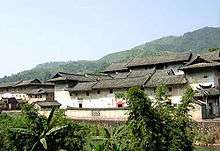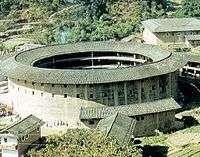Tulou



A tulou (simplified Chinese: 土楼; traditional Chinese: 土樓; pinyin: tǔlóu), or "earthen building", is a traditional communal residence found in Fujian Province South China, usually of a circular configuration surrounding a central shrine. These vernacular structures were occupied by clan groups.
Although most tulou were of earthen construction, the definition "tulou" is a broadly descriptive label for a building type and does not indicate construction type. Some were constructed out of cut granite or had substantial walls of fired brick. Most large-scale tulou seen today were built of a composite of earth, sand, and lime known as sanhetu rather than just earth.[1] The tulou is often three to four stories high. Often they would store food on the higher floors.
Due to their unorthodox and strange appearance from the outside they were once mistaken for missile silos by the Americans during the cold war.[2]
The noted Fujian Tulou, designated as UNESCO World Heritage site in 2008, is a small and specialized subgroup of tulou, known for their unique shape, large scale, and ingenious structure. There are more than 20,000 tulou in southern Fujian. Approximately 3,000 of them are Fujian Tulou, that is 15% of tulou belongs to Fujian Tulou category.
Contemporary references
Film
- In Secrets of the Furious Five, the Bao Gu Orphanage is a tulou.
- Portions of Stephen Chow's "Kung Fu Hustle" take place at a tulou.
Video Games
- In Front Mission 3 the main cast briefly goes to Yongding, where tulous can be seen in the background. The NPCs at the Yongding bar talk about tolous when you speak to them.
See also
External links
| Wikimedia Commons has media related to Tulou. |
- National Geographic China's Remote Fortresses Lose Residents, Gain Tourists
- http://www.chinadwelling.dk/images/htm/13_01.htm
- http://www.chinadwelling.dk/hovedsider/construction-tekst.htm
- http://whc.unesco.org/en/tentativelists/1689/
- From the Earth Article about the Tulou earth villages of the Fujian Hakka
References
- ↑ Knapp, Ronald G.. China's old dwellings. Honolulu: University of Hawaiʻi Press, 2000. 266. Print.
- ↑ http://www.smh.com.au/travel/a-sight-for-poor-spies-20090312-8w3e.html